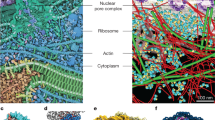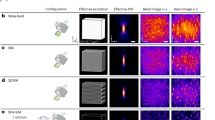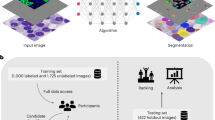Abstract
Two-photon fluorescence microscopy1 enables scientists in various fields including neuroscience2,3, embryology4 and oncology5 to visualize in vivo and ex vivo tissue morphology and physiology at a cellular level deep within scattering tissue. However, tissue scattering limits the maximum imaging depth of two-photon fluorescence microscopy to the cortical layer within mouse brain, and imaging subcortical structures currently requires the removal of overlying brain tissue3 or the insertion of optical probes6,7. Here, we demonstrate non-invasive, high-resolution, in vivo imaging of subcortical structures within an intact mouse brain using three-photon fluorescence microscopy at a spectral excitation window of 1,700 nm. Vascular structures as well as red fluorescent protein-labelled neurons within the mouse hippocampus are imaged. The combination of the long excitation wavelength and the higher-order nonlinear excitation overcomes the limitations of two-photon fluorescence microscopy, enabling biological investigations to take place at a greater depth within tissue.
This is a preview of subscription content, access via your institution
Access options
Subscribe to this journal
Receive 12 print issues and online access
$209.00 per year
only $17.42 per issue
Buy this article
- Purchase on Springer Link
- Instant access to full article PDF
Prices may be subject to local taxes which are calculated during checkout





Similar content being viewed by others
References
Denk, W., Strickler, J. H. & Webb, W. W. Two-photon laser scanning fluorescence microscopy. Science 248, 73–76 (1990).
Kerr, J. N. D. & Denk, W. Imaging in vivo: watching the brain in action. Nature Rev. Neurosci. 9, 195–205 (2008).
Dombeck, D. A., Harvey, C. D., Tian, L., Looger, L. L. & Tank, D. W. Functional imaging of hippocampal place cells at cellular resolution during virtual navigation. Nature Neurosci. 13, 1433–1440 (2010).
Olivier, N. et al. Cell lineage reconstruction of early zebrafish embryos using label-free nonlinear microscopy. Science 329, 967–971 (2010).
Williams, R. M. et al. Strategies for high-resolution imaging of epithelial ovarian cancer by laparoscopic nonlinear microscopy. Trans. Oncol. 3, 181–194 (2010).
Jung, J. C., Mehta, A. D., Aksay, E., Stepnoski, R. & Schnitzer, M. J. In vivo mammalian brain imaging using one- and two-photon fluorescence microendoscopy. J. Neurophysiol. 92, 3121–3133 (2004).
Levene, M. J., Dombeck, D. A., Kasischke, K. A., Molloy, R. P. & Webb, W. W. In vivo multiphoton microscopy of deep brain tissue. J. Neurophysiol. 91, 1908–1912 (2004).
Kleinfeld, D., Mitra, P. P., Helmchen, F. & Denk, W. Fluctuations and stimulus induced changes in blood flow observed in individual capillaries in layers 2 through 4 of rat neocortex. Proc. Natl Acad. Sci. USA 95, 15741–15746 (1998).
Svoboda, K., Helmchen, F., Denk, W. & Tank, D. W. Spread of dendritic excitation in layer 2/3 pyramidal neurons in rat barrel cortex in vivo. Nature Neurosci. 2, 65–73 (1999).
Theer, P., Hasan, M. T. & Denk, W. Two-photon imaging to a depth of 1000 µm in living brains by use of a Ti:Al2O3 regenerative amplifier. Opt. Lett. 28, 1022–1024 (2003).
Kobat, D. et al. Deep tissue multiphoton microscopy using longer wavelength excitation. Opt. Express 17, 13354–13364 (2009).
Kobat, D., Horton, N. G. & Xu, C. In vivo two-photon microscopy to 1.6-mm depth in mouse cortex. J. Biomed. Opt. 16, 106014 (2011).
Helmchen, F. & Denk, W. Deep tissue two-photon microscopy. Nature Methods 2, 932–940 (2005).
Balu, M. et al. Effect of excitation wavelength on penetration depth in nonlinear optical microscopy of turbid media. J. Biomed. Opt. 14, 010508 (2009).
Sacks, Z. S., Kurtz, R., Juhasz, T., Spooner, G. & Mouroua, G. A. Subsurface photodisruption in human sclera: wavelength dependence. Ophthalmic Surg. Lasers Imag. 34, 104–113 (2003).
Kou, L., Labrie, D. & Chylek, P. Refractive indices of water and ice in the 0.65- to 2.5-µm spectral range. Appl. Opt. 32, 3531–3540 (1993).
Xu, C., Zipfel, W., Shear, J. B., Williams, R. M. & Webb, W. W. Multiphoton fluorescence excitation: new spectral windows for biological nonlinear microscopy. Proc. Natl Acad. Sci. USA 93, 10763–10768 (1996).
Hell, S. W. et al. Three-photon excitation in fluorescence microscopy. J. Biomed. Opt. 1, 71–74 (1996).
Wokosin, D. L., Centonze, V. E., Crittenden, S. & White, J. Three-photon excitation fluorescence imaging of biological specimens using an all-solid-state laser. Bioimaging 4, 208–214 (1996).
Zysset, B., Beaud, P. & Hodel, W. Generation of optical solitons in the wavelength region 1.37–1.49 µm. Appl. Phys. Lett. 50, 1027–1029 (1987).
Wang, K. & Xu, C. Tunable high-energy soliton pulse generation from a large-mode-area fiber and its application to third harmonic generation microscopy. Appl. Phys. Lett. 99, 071112 (2011).
Limpert, J. et al. High-power rod-type photonic crystal fiber laser. Opt. Express 13, 1055–1058 (2005).
Barad, Y., Eisenberg, H., Horowitz, M. & Silberberg, Y. Nonlinear scanning laser microscopy by third harmonic generation. Appl. Phys. Lett. 70, 922–924 (1997).
Müller, M., Squier, J., Wilson, K. R. & Brakenhoff, G. J. 3D microscopy of transparent objects using third-harmonic generation. J. Microsc. 191, 266–274 (1998).
Farrar, M. J., Wise, F. W., Fetcho, J. R. & Schaffer, C. B. In vivo imaging of myelin in the vertebrate central nervous system using third harmonic generation microscopy. Biophys. J. 100, 1362–1371 (2011).
Livet, J. et al. Transgenic strategies for combinatorial expression of fluorescent proteins in the nervous system. Nature 450, 56–62 (2007).
Franklin, K. B. J. & Paxinos, G. Mouse Brain in Stereotaxic Coordinates (Academic Press, 2008).
Murphy, P. A. et al. Notch4 normalization reduces blood vessel size in arteriovenous malformations. Sci. Transl. Med. 4, 117ra8 (2012).
Pologruto, T. A., Sabatini, B. L. & Svoboda, K. ScanImage: flexible software for operating laser scanning microscopes. Biomed. Eng. Online 2, 13 (2003).
Binding, J. et al. Brain refractive index measured in vivo with high-NA defocus corrected full-field OCT and consequences for two-photon microscopy. Opt. Express 19, 4833–4847 (2011).
Bacallao, R., Sohrab, S. & Phillips, C. in Handbook of Biological Confocal Microscopy (ed. Pawley, J. B.) 368–380 (Springer, 2006).
Rosidi, N. L. et al. Cortical microhemorrhages cause local inflammation but do not trigger widespread dendrite degeneration. PLoS ONE 6, e26612 (2011).
Acknowledgements
This work is partially funded by grants from the National Institutes of Health (NIH; R01CA133148, R01EB014873 and R21RR032392). N.G.H. is supported by the National Science Foundation Graduate Research Fellowship Program (DGE-0707428). The authors acknowledge discussions with D. Dombeck, as well as N. Nishimura and J. Rubin, regarding preparation of the ex vivo brain slices.
Author information
Authors and Affiliations
Contributions
C.X. initiated and supervised the study. N.G.H., K.W., D.K. and C.G.C. performed the experiments and data analysis. N.G.H., K.W., D.K. and C.X. contributed to the writing and editing of the manuscript. C.B.S. and C.X. contributed to the design of the experiments. F.W. and C.X. contributed to the laser source design.
Corresponding author
Ethics declarations
Competing interests
The authors declare no competing financial interests.
Supplementary information
Supplementary information
Supplementary information (PDF 982 kb)
Rights and permissions
About this article
Cite this article
Horton, N., Wang, K., Kobat, D. et al. In vivo three-photon microscopy of subcortical structures within an intact mouse brain. Nature Photon 7, 205–209 (2013). https://doi.org/10.1038/nphoton.2012.336
Received:
Accepted:
Published:
Issue Date:
DOI: https://doi.org/10.1038/nphoton.2012.336
This article is cited by
-
Optical characteristics and solar cell performance of (MAPbBr3)x ((MACl)0.28FA0.98Cs0.02PbI3)1−x with various composition ratios
Journal of Materials Science: Materials in Electronics (2024)
-
A three-photon head-mounted microscope for imaging all layers of visual cortex in freely moving mice
Nature Methods (2023)
-
Fluorescence-amplified nanocrystals in the second near-infrared window for in vivo real-time dynamic multiplexed imaging
Nature Nanotechnology (2023)
-
Miniature three-photon microscopy maximized for scattered fluorescence collection
Nature Methods (2023)
-
Computational conjugate adaptive optics microscopy for longitudinal through-skull imaging of cortical myelin
Nature Communications (2023)



